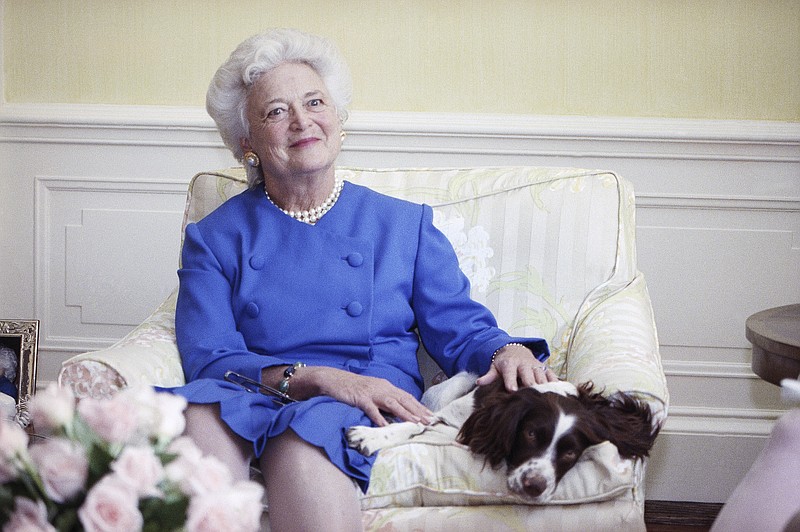More Info
Visit honoringchoicestn.org for resources.
Former first lady Barbara Bush's death has ignited discussion about end-of-life choices and the difference between hospice and palliative care - a conversation experts hope will continue.
Bush, who died Tuesday at the age of 92, had for years experienced congestive heart failure, chronic obstructive pulmonary disease and was treated for other illnesses, according to media reports.
Days before her death, Bush's family issued a statement saying she had decided not to seek medical treatment and would focus on "comfort care."
Dr. Joanne Lynn, director of the program to improve elder care at Altarum Institute, worked with Bush years ago, when she was a congressional spouse volunteering at the Washington Home for chronically ill patients, according to a Tribune News Service report. Bush helped with the founding of the hospice program there.
"We have so few examples in visible leadership positions" of public figures promoting palliative care, or "comfort care," Lynn said.
Bush is now serving as that example.
"We just need to start talking," said Dr. Bryan Johnson, medical director for palliative care at Erlanger Health System. "It goes a long way toward alleviating the stress and guilt and worry of your loved ones."
Hospice is supportive care during the last six months of life when curative treatment is no longer planned or beneficial, whereas palliative medicine is quality of life care while still undergoing aggressive treatment and helps keeps family involved in health decisions and plans.
Through years working in adult medicine and later in hospice, Johnson developed a knack for managing the symptoms of his sickest patients.
"I learned a lot about what you might call, or what I thought were, folk remedies - what we call now holistic medicine," he said.
Holistic medicine is an art and science that addresses the whole person - body, mind and spirit - a concept at the root of both hospice and palliative care. Both use a team of doctors, nurses, social workers and spiritual advisers, upon request, who work with patients and their families.
"Their metaphysical suffering can be far greater than their bone pain," Johnson said. But misconception and reluctance to engage in difficult conversations make palliatve care "massively underutilized" and prevent many people from receiving potentially life-changing treatment.
"There's a poor grasp, in general, on prognosis, and patients think it's giving up," he said. "When we can see the patient further upstream, we are really the prognostication experts. People don't have to suffer."
"We see people with a serious or life-limiting illness who have a very high symptom burden," Johnson said. "We take on that burden, and it frees up the other physicians to treat the illness."
Ronnie Haygood, 56, was referred to Erlanger's palliative care team by his oncologist about six years ago after surgery left him in severe pain.
"There's been a lot of times that I felt like just forgetting about it, just laying it down and giving up the treatments, especially when I was on the chemo," Haygood said. "They try to encourage you to keep going. I really don't know that I would've been able to push and do the things that I've done without them."
Although Haygood hadn't heard of palliative care before, he said it's not only supported him through years of lung cancer, but his social worker, Jackie, helped him navigate personal and emotional challenges - like a bad breakup and writing his advanced directives, which spell out his end-of-life wishes.
"I seriously advise everybody should do that, because there's going to be a lot of heartache for a lot of people if they don't. Not only them, but siblings and everyone can turn against each other," he said.
Only about one-third of U.S. adults have advanced directives, according to a study published in July 2017, which Dr. Greg Phelps, chief medical officer for Hospice of Chattanooga, said isn't enough.
"We plan for weddings, birthdays, but we don't plan for end-of-life care, and if you don't plan, you're not going to get what you want," Phelps said.
Aside from changing the public's perception that palliative care is "hospice lite" or "soft hospice," Johnson said health care providers need to change the way they discuss terminal illness, too.
"Most physicians are trained to ignore their gut feeling about this - subconsciously they feel like they've failed if their patient dies," he said.
Phelps said hospice has to overcome similar hurdles as palliative care.
"The popular perception of hospice is that you give up hope, and we give you morphine and kill you," he said, adding that patients in hospice and palliative care typically live longer than their matched counterparts.
"There comes a point where the more you do, the worse you make it," he said. "It really is a tragedy, because the whole purpose is to get people stabilized to enjoy life."
Contact staff writer Elizabeth Fite at efite@timesfreepress.com or 423-757-6673.
